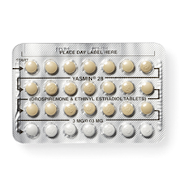“It depends on what type of pill you’re on and how far into the pill pack you are. If you’re on the
combination pill, and it’s been
48 hours or less since your last pill, just take it as soon as you remember. Take the pill you missed even if that means you’re taking two at the same time. If you take two pills at once, you might feel nauseous, so try taking them with food. Keep taking the rest of the pills in your pack as planned; you don’t need to do anything else to be protected from pregnancy.
If you are using a combination pill and it’s been
more than 48 hours since your last pill, take one of the missed pills as soon as you remember, leaving the others in the pack. Then take today’s dose at the time you normally would (even if it means taking two at the same time)
AND use a backup method of birth control, like condoms, every time you have sex for the next seven days. If you miss a pill by more than 48 hours in the last week of your pack, skip any hormone-free pills and start a new pack the day after you finish the current pack.
The first week of your pills is the most important to prevent ovulation. If you miss a pill by more than 48 hours in the first week, that’s a bigger deal than a missed pill in a later week. In addition to taking your missed pill ASAP, consider taking [EC] if you’ve had sex in the last 5 days and for the next 7 days use a back-up method of birth control every time you have sex.
If you’re on any brand of
mini-pill (also called the progestin-only pill) besides
Slynd, there are totally different rules. If you’re more than 3 hours late taking a pill during any week of your pill pack, you could get pregnant if you have sex without using another method of birth control, and you need to use a backup method for 48 hours. Considering taking EC if you’ve had sex in the last 5 days.”
“It depends on what type of pill you’re on and how far into the pill pack you are. If you’re on the combination pill, and it’s been 48 hours or less since your last pill, just take it as soon as you remember. Take the pill you missed even if that means you’re taking two at the same time. If you take two pills at once, you might feel nauseous, so try taking them with food. Keep taking the rest of the pills in your pack as planned; you don’t need to do anything else to be protected from pregnancy.
If you are using a combination pill and it’s been more than 48 hours since your last pill, take one of the missed pills as soon as you remember, leaving the others in the pack. Then take today’s dose at the time you normally would (even if it means taking two at the same time) AND use a backup method of birth control, like condoms, every time you have sex for the next seven days. If you miss a pill by more than 48 hours in the last week of your pack, skip any hormone-free pills and start a new pack the day after you finish the current pack.
The first week of your pills is the most important to prevent ovulation. If you miss a pill by more than 48 hours in the first week, that’s a bigger deal than a missed pill in a later week. In addition to taking your missed pill ASAP, consider taking [EC] if you’ve had sex in the last 5 days and for the next 7 days use a back-up method of birth control every time you have sex.
If you’re on any brand of mini-pill (also called the progestin-only pill) besides Slynd, there are totally different rules. If you’re more than 3 hours late taking a pill during any week of your pill pack, you could get pregnant if you have sex without using another method of birth control, and you need to use a backup method for 48 hours. Considering taking EC if you’ve had sex in the last 5 days.”

